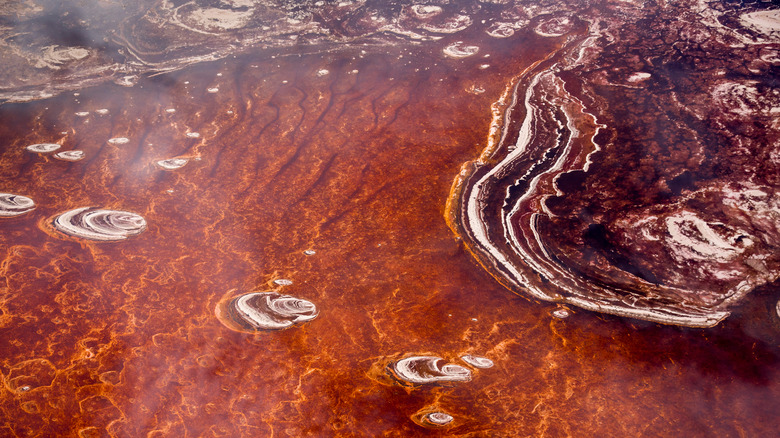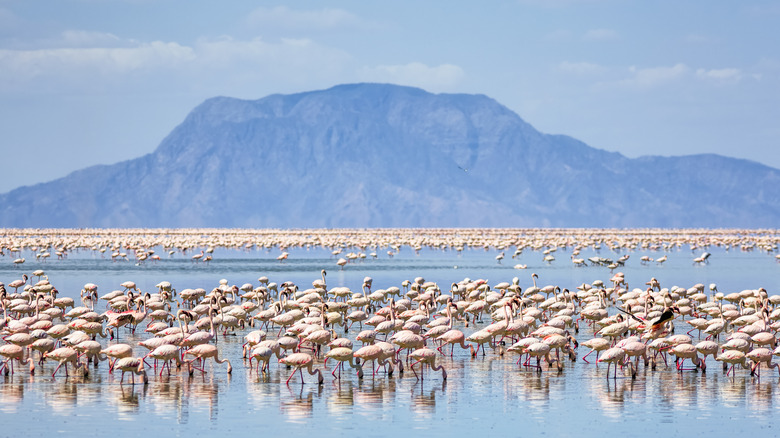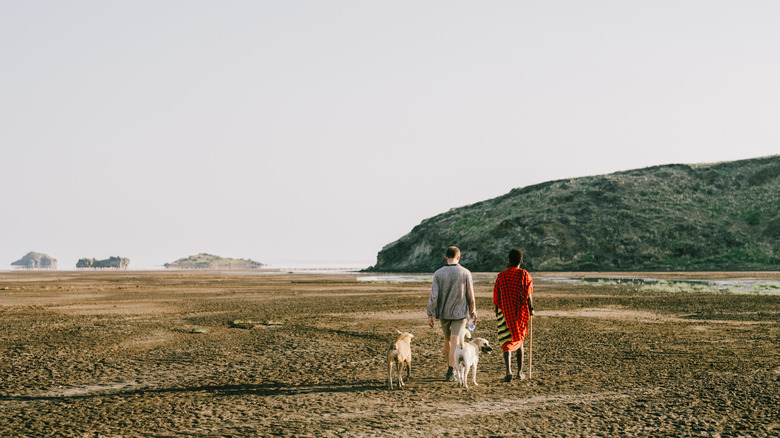Africa's Bright Red Lake Natron Supposedly Turns Animals To Stone — Here's How To Visit
In the northern reaches of Tanzania, near the border with Kenya, lies one of Africa's most captivating natural wonders: Lake Natron. This otherworldly body of water, measuring 35 miles by 15 miles and renowned for its bright red coloring, holds quite the macabre reputation that seems plucked straight from mythology. According to local lore, Lake Natron turns animals to stone. While this isn't entirely accurate, the truth behind this strange natural phenomenon is just as fascinating. Lake Natron's ability to preserve dead animals as though petrified is rooted in extreme alkalinity and high temperatures. The lake's crimson waters can reach temperatures of up to 140 degrees Fahrenheit with a pH level exceeding 10, sometimes reaching 12, making it one of the most alkaline bodies of water in the world.
The high concentration of sodium bicarbonate, magnesite deposits, and other minerals creates a caustic, natron-rich environment that can rapidly calcify dead organisms, effectively turning them into mummified sculptures. In fact, ancient Egyptians used these very minerals for mummification. This process, however, does not affect living animals in the same way. Instead, it's more common to find migrating birds, which mistake the lake's reflective surface for empty space and succumb to the water's harsh conditions after falling in. When the water levels drop during Tanzania's dry season from June to September, the stiff, chemically preserved bodies get washed up along the coastline. Photographer Nick Brandt captured many stark images of these petrified animals in his 2013 book, "Across the Ravaged Land."
Lake Natron: life and death
The lake's vivid coloration is definitely a sight to behold, especially from an aerial view. The coloring can even be seen from space! This striking hue is due to the presence of salt-loving microorganisms, including cyanobacteria and haloarchaea. These microorganisms thrive in the saline environment, and during their photosynthetic process, they produce red pigments, giving Lake Natron its distinctive hue. Depending on the time of year and the lake's water levels, the color can range from deep reds and oranges to more subdued browns and pinks. However, because of the ammonia-level pH quality of the water, not much else lives in the lake other than two fish species: Alcolapia latilabris and Alcolapia ndalalani.
Despite the fact that this is one of the most dangerous vacation destinations that travelers flock to, Lake Natron is actually a critical habitat for one particular species. Most notably, it serves as the largest breeding ground in the world for lesser flamingoes (Phoenicopterus minor species), who aren't negatively harmed by the bacteria in the water. An estimated 75% of the world's population of flamingos are born here, and around 2,500,000 inhabit the area between July and October, drawn by the lake's isolated location and the abundance of nutrient-rich cyanobacteria, which is their primary food source. Zebras, ostriches, kudus, golden jackals, and a few other animal species also live in the surrounding areas. Tanzania's abundant wildlife definitely makes it a must-visit country to add to your Africa bucket list.
Planning your visit
Visiting Lake Natron is an adventure that offers a glimpse into one of Earth's most unusual ecosystems. Arusha is the closest major city, well-connected by air travel and road. From Arusha, it's approximately a four-hour drive to the lake. The journey is well worth it and will take you through some stunning landscapes, including the Great Rift Valley and the base of the active Ol Doinyo Lengai volcano. You can combine your trip to Lake Natron with an adventure to Mount Kilimanjaro (check out our complete guide to hiking Mount Kilimanjaro). The best time to visit is during the dry season, from June to September, when the roads are more passable. The peak wildlife season lasts between December and January, as this is when flamingoes' eggs hatch.
Overall, the primary attraction at the lake is observing the massive flocks of lesser flamingos. Guided bird-watching tours are available and recommended. The area also offers several hiking opportunities, including treks to the Ngare Sero Waterfalls and the challenging, steep climb up Ol Doinyo Lengai for stunning views of Lake Natron from its summit. Cultural experiences, such as interacting with the local Maasai communities, can provide an even deeper understanding of the region. For overnight stays, Lake Natron Camp is an eco-friendly option that has a natural pool where you can actually swim, as taking a dip in Lake Natron itself isn't a good idea. Although it wouldn't turn you into stone, the water is caustic and dangerous to humans.


